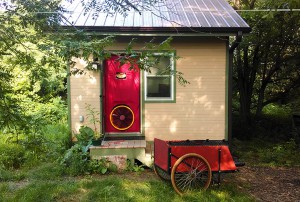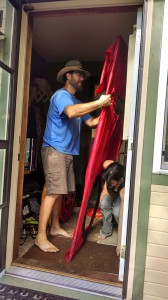
With winter still making the rounds, now is a good time to talk about energy — namely, the energy we use to heat our favorite hangouts. After all, most of the energy used in our homes and businesses goes toward temperature control.
Consider this: according to the U.S. Energy Information Administration, in 2012 the United States used over 333 billion kWh of energy for heating and cooling purposes. That’s about 25% of our total consumption, or more than a thousand kilowatts per person per year. Most of that electricity came from burning coal. That burnt coal translates to 5,720 pounds of Earth-warming CO2 going into the atmosphere, and 4,160 pounds of life-sustaining oxygen burned up in the process — per person.
With global climate change kicking into high gear, we are going to have to make some major adjustments to our daily lives if we want our grandchildren’s grandchildren to have something to look forward to besides high-speed highway chases with Lord Humungus (you know, the villain from the movie Road Warrior?).
For tips on cutting your heating bill (and decreasing your carbon footprint),
check out the bottom of this infographic and the resources on this page.
Getting back to the blower door referenced in the title of this piece, over the course of a few months this last building season Builder Bear worked with our resident queen of aesthetics, Jennifer Martin, to quantify and compare the different energy efficiency ratings of many of the buildings at Dancing Rabbit. For purposes of this article, I am going to call their dynamic duo Team JB. (Jennifer’s initial comes first, because that’s how she rolls.)
The point of this testing is to measure air flow in a structure at elevated pressure, using a power law equation that looks like a bowl of Greek alphabet soup. It starts with a machine called a blower-door, which consists of a frame-mounted fan attached to a manometer, an instrument that measures air pressure, and a computer for performing calculations.
You squeeze this big bad wolf into a door or window frame and electronically record the number of air pressure changes per hour, as it sucks the atmosphere out of your structure at 50 Pascals of pressure. While the machine is running, you can seek out leakage areas using either an infrared sensor that detects subtle temperature differentials, or a special type of smoke stick, which will allow you to see air movement with the naked eye.
After enough data has been gathered, the computer spins its hamster wheels and you can get a sense of how permeable your building is, and, if all of the unchecked orifices in the walls of the structure were concentrated in one gaping, energy-wasting hole, how big that hole would be.

OK, so anybody would patch a wall if it looked like Swiss cheese, but what’s the big deal about a few pinhole leaks here and there? Let’s look at the concept of asymptotic thermal transfer — this refers to the tendency of hot things to want to be cold, while cold things want to warm up. Basically, molecules are like teenyboppers: they all want to be just like each other. This means that a body of high-energy hot air will tend to transfer energy over to an adjacent body of low-energy cold air. When you’re trying to keep a room cool in summer/warm in winter, this dimension of thermodynamics can translate into more money spent, more coal burned and more rapid worldwide climate change.
So far, Team JB has studied twenty-eight buildings at DR, which currently range in number of air changes per hour from the low single digits up to about 30. (For a little context, the current International Building Code standard is 7 changes per hour, while the Passive House standard is a challenging 0.6 changes per hour.)
Right now, it’s difficult to be sure what the data means, but it is clear that in terms of air tightness, conventionally constructed buildings at Dancing Rabbit, such as the Common House and the Casa de Cultura, perform better than buildings featuring more natural building techniques.
But how do we know we aren’t comparing apples to orangutans? Simple: in addition to comparing the base number of air changes per hour, the process also includes looking at the ratio of the cubic volume of space inside the building to the corresponding volume of air moving in from outside, which provides a balanced method of contrasting buildings of varying sizes and makeup. In other words, per unit of volume, conventional buildings have fewer air leaks, and therefore less thermal bridging between the indoor and outdoor atmospheres.
Lobelia, Bear and Alyssa’s earthen-plastered straw bale building, currently tests at 11.5 ach/50 (air changes per hour at 50 pascals of pressure). This is after Bear sealed the joinery between timber and plaster with silicone caulk to ward off the icy breath of a particularly frigid winter. He made it clear to me that this small adjustment made a noticeable difference right away, and that even on the coldest nights (-30°F) the home only lost about one degree per hour after the fire in the wood burning stove had gone out.
Air tightness correlates very closely with energy efficiency because it restricts the transfer of heat energy in and out of a building. In a conventionally-built structure, the building envelope includes a range of sheet goods like plywood and drywall, as well as airproof tape, weatherstripping and insulation, all of which contribute to reduced levels of air infiltration. In naturally-built homes, comprised of materials like timber, straw, and clay-based cob, it is inevitable that numerous leaks will develop wherever two disparate materials meet, such as the imperfect union between a post of local Osage orange and the plaster adjacent to it.
Energy efficiency isn’t the only criteria we use, however, when assessing the value of natural building methods versus conventional techniques. Embodied pollution, for instance, is a critical factor to consider as well. Embodied pollution is a way of referring to the overall environmental impact of any given construction material, including details of its manufacture related to atmospheric carbon output, water pollution and habitat destruction; its toxicity; and even how much pollution is generated in shipping the material from A to B.
In almost all cases, conventional building materials hold much higher levels of embodied pollution than locally obtained natural alternatives. Here at Dancing Rabbit, many homes are built mostly of timber and straw harvested a short distance away and clay excavated within spitting distance — hardly any embodied pollution at all.
So how do we strive for energy efficiency in our homes while holding on to our ecological values? Bear makes a strong case for conventionally built structures on both counts. While embodied pollution is undeniably higher for conventional building materials, Team JB claims that lower ongoing energy expenditure for temperature control, protracted over the lifespan of the structure, will afford an environmental advantage in the long run. Natural alternatives, boasting much lower embodied pollution at the outset, require higher ongoing energy inputs to maintain livable conditions, since the shortcomings of materials like straw and clay will progressively take a toll on energy efficiency. Team JB is still in the early stages of their research, so this claim is difficult to prove on paper, but so far it seems to bear out (pun intended).
Like most things life, it’s often optimal to strike a balance, which in our case means striving to make clever and responsible use of all the materials we have available to us, both ancient and new. We’re thinking and talking a lot about how we can bring the best of both green and natural building methods together in our eco-superstructures of the future. The Green Community Center that has been designed for Dancing Rabbit is one such hybrid. As designed, this building would make use of reclaimed timber for its stick-frame skeleton, a mixture of straw bales and blown cellulose for insulation, lime plaster, and a plywood barrier, along with modern glazing and innovative use of cutting edge weatherproofing materials in all phases of construction.
I want to make one last point on this question of energy efficiency in our homes — even if you believe global warming is a hoax and/or you couldn’t care less about your personal impact on the environment, you still have a good reason to seal the cracks in your own attic: money.
Go take a look at your meter. Gaze into the swirling dials and forecast your future. How much juice are you going to be using in twenty years, and what do you expect to pay for it? I’m no fortuneteller, and I’m not the betting type, but if I were, I’d bet that in twenty years — with global temperatures fluctuating wildly and international demand for energy increasing every day — you’re going to be feeling nostalgic about whatever price you’re paying right now. So pick up a caulking gun and get down to business as soon as you can; you won’t regret it.
If you want to research all the ways that you can keep a little more money in your pocket while putting a little less carbon into the air, you’ll find a comprehensive set of resources here. There you can delve into the nitty-gritty of ecoaudits, quick and inexpensive energy saving upgrades you can make to your home, and a long list of Q&As provided by the experts. The first step to getting serious is to contract a local company who can run a blower-door test in your space and identify the areas you need to address.
Thanks for reading, and do consider visiting Dancing Rabbit, where you can learn all about the sustainable life and culture we want to share with the world, including efficient ecological building methods and so much more!
• • •

Vick is a misanthropic science geek with raconteur tendencies, metamorphosing from Las Vegas casino chef to rural eco-warrior. He spends his time writing novels and working online, when he’s not playing board games with Dancing Rabbit visitors.
